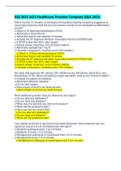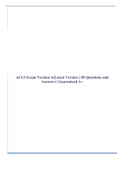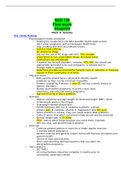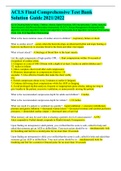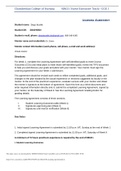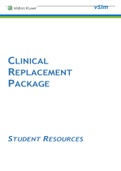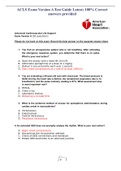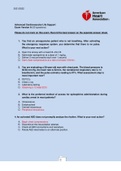Washtenaw Community College
Latest uploads at Washtenaw Community College. Looking for notes at Washtenaw Community College? We have lots of notes, study guides and study notes available for your school.
-
59
- 0
-
3
All courses for Washtenaw Community College
Latest notes & summaries Washtenaw Community College
RQI 2025 ACLS Healthcare Provider Complete Q&A. Within the first 10 minutes, on the basis of the patient showing symptoms suggestive of myocardial ischemia, what will your first actions include (if not completed by EMS before arrival)? o Obtain a 12-lead electrocardiogram (ECG) o Administer a blood thinner o Administer aspirin and establish IV access o Activate the ST-segment elevation myocardial infarction (STEMI) team o If SPO2 is less than 90%, start oxygen o Assess airway, breathing, ...
Advanced Cardiovascular Life Support Exam Version A (50 questions) Please do not mark on this exam. Record the best answer on the separate answer sheet. 1. You find an unresponsive patient who is not breathing. After activating the emergency response system, you determine that there is no pulse. What is your next action? A. Open the airway with a head tilt–chin lift. B. Administer epinephrine at a dose of 1 mg/kg. C. Deliver 2 rescue breaths each over 1 second. D. Start chest compressions at a...
NUR 128 Final exam blueprint Week 13: Sexuality 19.2 Family Planning o Preconception health promotion ▪ Helping the couple be in the best possible health state so they don’t enter pregnancy with unnecessary health risks. ▪ Stop smoking and limit secondhand smoke. ▪ Avoid or limit caffeine. ▪ No alcohol or drugs ▪ Discuss the use of RX drugs with HCP. This includes prescription & non- prescription drugs. Accutane (acne medication) was mentioned. ▪ If woman has thyroid dis...
ACLS_Exam_Version_A. - Advanced Cardiovascular Life Support
ACLS Final Comprehensive Test Bank Solution Guide updated 2021/2022, A+ Solutions-BLS & Chocking Relief of Adults, Children, Infants; Opioid Overdose; EKG interpretation; Cardiac anatomy; Team dynamics; BLS/Primary/Secondary Assessment; H's & T's; Airway Management; Bradycardia ACLS Algorithm; ACS ACLS Algorithm; Stroke ACLS Algorithm; Tachycardia ACLS Algorithm; Immediate Post-Cardiac Arrest Care ACLS Algorithm; Phamacology What is the most common cause of cardiac arrest in children? - respir...
For Week 1, complete the Learning Agreement with self-identified goals to meet Course Outcomes (COs) and initial plans to meet those self-identified goals; review the TIPS document to help you and discuss your goals and plans with your mentor. Your mentor must sign the Learning Agreement for your Week 1 submission. The agreement should be revised each week to reflect completed goals, additional goals, and changes to the plan dictated by the actual experience or revisions suggested by facult...
STUDENT INSTRUCTIONS FOR VIRTUAL CLINICAL REPLACEMENT This activity packet is intended to be used with your assigned virtual patient found in vSim. The Six Step learn flow in vSim is to be followed as instructed below. Once you have completed the Six Steps, in addition to this Clinical Replacement Activity Packet, submit for grading as instructed in your syllabus. LEARN FLOW - STEP ONE Finish the Suggested Readings, then complete the following four activities: Clinical Worksheet Plan...
ACLS Exam Version A Test Guide Latest; 100% Correct answers provided//ACLS Exam Version A Test Guide Latest; 100% Correct answers provided//ACLS Exam Version A Test Guide Latest; 100% Correct answers provided
ACLS Exam Version A Test Guide Latest; 100% Correct answers provided//ACLS Exam Version A Test Guide Latest; 100% Correct answers provided//ACLS Exam Version A Test Guide Latest; 100% Correct answers provided
1. You find an unresponsive patient who is not breathing. After activating the emergency response system, you determine that there is no pulse. What is your next action? A. Open the airway with a head tilt–chin lift. B. Administer epinephrine at a dose of 1 mg/kg. C. Deliver 2 rescue breaths each over 1 second. D. Start chest compressions at a rate of at least 100/min.

